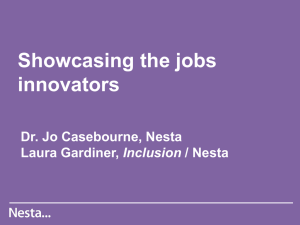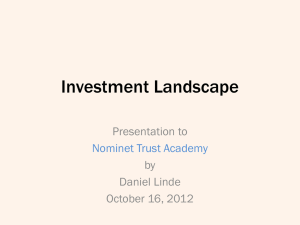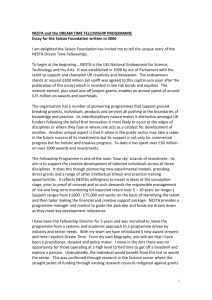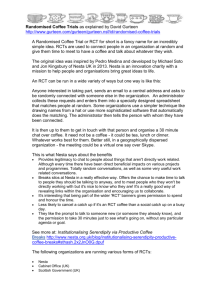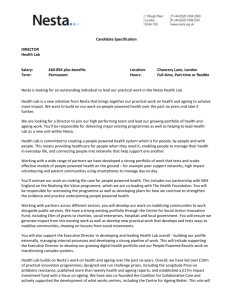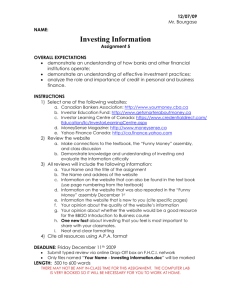StandardS of EvidEnCE for impaCt invESting
advertisement
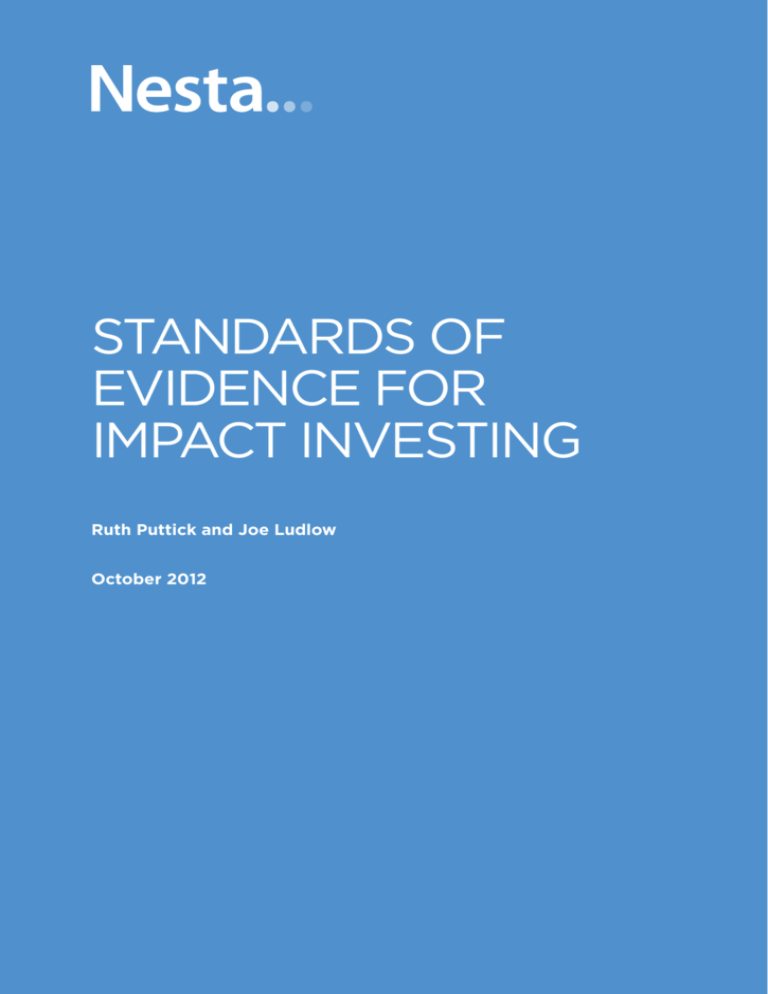
1 THE VENTURE CROWD Crowdfunding equity investment into business Standards of Evidence for Impact Investing Ruth Puttick and Joe Ludlow October 2012 2 THE VENTURE CROWD Crowdfunding equity investment into business About Nesta Nesta is the UK’s innovation foundation. We help people and organisations bring great ideas to life. We do this by providing investments and grants and mobilising research, networks and skills. We are an independent charity and our work is enabled by an endowment from the National Lottery. Nesta Operating Company is a registered charity in England and Wales with a company number 7706036 and charity number 1144091. Registered as a charity in Scotland number SC042833. Registered office: 1 Plough Place, London, EC4A 1DE wwww.nesta.org.uk © Nesta 2012. 3 Standards of Evidence for Impact Investing Introduction Impact Investing is gaining ground. The prospect of being able to tackle social challenges whilst making a profit is an attractive proposition. But too often evidence of impact is missing. We need evidence to establish whether a product or service is benefitting those it sets out to serve, and then to focus investment on products and services that can make the most difference. To help us achieve this we have developed a new approach, Standards of Evidence for Impact Investing. We have developed this new approach to help guide the decisions made by Nesta Impact Investments. This fund will be investing in high–risk or earlier–stage innovations where we intend to create value, not only in financial terms but also in terms impact. This short discussion paper introduces Nesta Impact Investments fund and the Standards of Evidence for Impact Investing. We discuss why the Standards of Evidence were developed and the implications we hope they will have for our fund. The Standards of Evidence for Impact Investing have a number of key features, these are summarised below: •The Standards of Evidence are on a 1 to 5 scale. The starting point for all those we will fund is Level 1, this involves a clear articulation of why a product or service could have a positive impact. As the levels are progressed, it will be expected that data is collected to isolate the impact to the product or service, that findings are validated externally, and then at Level 5, demonstrable evidence that the product or service can be delivered at multiple locations and still deliver a strong, positive impact. •The Standards of Evidence recognise the need to ensure that demand for evidence is appropriate for different stages of product or service development, that it doesn’t hamper innovation, and that it is realistic and proportionate. •The Standards of Evidence will be used to plan an evaluation strategy to inform product or service development and inform future funding decisions. •The different levels of the standards are intended to be dynamic and developmental. •For our Nesta Impact Investments, investing in an evaluation is a vital component of the investment package, and is just as important as increasing the capacity of an organisation to actually deliver the product or service. 4 Standards of Evidence for Impact Investing Why a new approach to impact measurement is needed “What’s weird to me is that while all impact investors know that you could never maximise profit without measuring it, they often fail to recognise that the same is true of impact”1 The monitoring and analysis of the financial risk and return of an investment is standard practice, yet the question of whether an investment is achieving a positive impact on social outcomes and goals is seldom rigorously answered. It seems strikingly obvious to test whether a product or service ‘is working’, but it seems that in impact investing there is no consensus on when to measure, what to measure and how to measure it. Or worse still, there is no attempt at all. This means that measurement is too often weak and inconsistent, and rarely captures what would have happened anyway or whether there any negative effects of the investment. Furthermore, little attention has been paid to capturing the potential and realised impact of earlier stage innovations, where a key part of the investment requirement is to generate greater evidence of if, and how, the innovation works. This is a real problem. We know that good intentions don’t necessarily lead to good outcomes. There are well known cases of people and organisations delivering services or products that mean well, who want to positively enhance the lives of their users and the wider community, but end up doing more harm than good.2 This means we need to get much better at understanding impact. Over the past few years there has been much debate about if and how the impact of social programmes can be measured. It now seems like this is moving from a debate to a reality with a number of initiatives and approaches cropping up to enable impact measurement to happen. At the same time the impact investment market is gaining ground.3 Government is also helping support and stimulate the market, with Big Society Capital set to have an investment pot worth up to £600 million, which is roughly four times the current market size.4 Like many others, we believe it is possible to more effectively measure social impacts. The approach we have developed is Standards of Evidence for Impact Investing. We plan to use the Standards of Evidence for Impact Investing to help understand whether the investments we make through the fund are working to achieve the desired impacts we want to see. 5 Standards of Evidence for Impact Investing About Nesta Impact Investments Before we outline the Standards of Evidence for Impact Investing, we will briefly introduce Nesta Impact Investments.5 The fund launched in late 2012 and aims to maximise the impact of social innovations, by growing ventures and strengthening their evidence. The fund invests in innovative ventures that address three major social needs in the UK: an ageing population; the learning, wellbeing and employability needs of children and young people and community sustainability (see Annex 1 for details on the outcomes associated with each of these areas). By providing investment capital to these ventures, over its eight– year life, Nesta Impact Investments aims to deliver public benefit within the target outcome areas, whilst achieving a financial return. Potential investees will be assessed according to our investment criteria6 which cover our financial, operational and impact requirements. Definition of key terms We define: 1. An output as a measurable unit of a product or a defined episode of service delivery directly produced by an investee’s activities. 2. An outcome as an observable, and measurable, change for an individual or organisation. We have already defined the outcomes we would like our investments to achieve across the three areas of ageing, community sustainability, and children and young people.7 3 . Impact as the effect on outcomes attributable to the output, which may be 3. positive or negative, and will be identified through high quality evaluation.8 4. 4 . Impact Risk is a concept we have developed to give an indication of the certainty that an output will lead to the stated impact. Impact and Impact Risk Our three target outcome areas relate to long–term and complex needs of individuals, communities or UK society as a whole. Furthermore, we are specifically seeking to invest in earlier–stage innovations with the potential for high impact, but where there may be little evidence available now that this will be achieved. So two key concepts are important to us: •Impact, as we have defined it in the text box, seeks to isolate through evaluation the effect on an outcome of the investee’s output. •Impact Risk is a concept we have developed to give an indication of the certainty that an output will lead to the stated impact. We use the standards of evidence to calibrate this. 6 Standards of Evidence for Impact Investing Public benefit and target populations Our target outcomes describe what positive change we want our investees to deliver. We also need to consider to whom this will be provided: our ‘target populations’. We have adopted three investment criteria to define our target population and ensure public benefit, which is important to Nesta as a registered charity. 1. Investing in inclusive innovations: the product/service innovation has the potential to address one or more of our target outcomes, for all those in the UK population for whom the outcome is relevant (the target population); 2. Accessibility: the business plan for the venture contains a credible long–term strategy to distribute the product/service to all segments of the target population and does not exclude any segment from the opportunity to benefit from the product/service; 3. Affordability: the business plan contains a credible long–term pricing and sales strategy that demonstrates how the product/service could be afforded by all segments of the target population and intends that the pricing and sales channels used do not create barriers to access. The impact objective of Nesta Impact Investments We have brought together the concepts discussed above to provide an impact objective for the fund, with three dimensions: 1. To invest in products and services which continue to produce evidence of positive impact on our target outcomes; 2. To increase the scale of this impact by growing the ventures and serving more of our target population; 3. To reduce Impact Risk by strengthening the evidence that helps to demonstrate investees are having an impact. Figure 1 illustrates the interplay between the first and third of these dimensions. It shows that the fund will aim to invest in early–stage innovations where potential impact is high, but where Impact Risk is also high. Through our investment, we believe we can reduce impact risk and that in doing so, whilst scaling–up output, we will deliver public benefit. We also believe that increasing impact performance will often lead to an increase in financial value. 7 Standards of Evidence for Impact Investing Figure 1: How we conceptualise, impact, impact risk and evidence Low 5 Nesta Impact Investments creates public benefit through its investments by 4 Standards of Evidence for Impact Investment • Increasing impact Some investments will under perform • Reducing impact risk • And growing outputs (not shown here) Impact Risk 3 2 We invest in innovation We won’t invest here High 1 Negative Neutral Impact Positive Standards of Evidence For Impact Investing This now leads to the question: how will we know whether the products and services we fund are having a positive impact? To help answer this we have developed Standards of Evidence for Impact Investing. How we developed the Standards of Evidence for Impact Investing There are numerous ‘levels’ and ‘standards’ of evidence that have been developed to help structure how evidence is gathered, interpreted and assessed.9 Our starting point was the Standards of Evidence that underpin the Greater London Authority’s Project Oracle,10, 11 an innovative, city–wide programme that seeks to build the evidence behind youth programmes in London.12 We started with these standards of evidence because they effectively manage to retain academic standards of rigour whilst ensuring that the evidence requirements are appropriate to the development of services and products. This is fundamentally important for helping to ensure that the collection of evidence doesn’t hinder innovation.13 We have amended and adapted the Oracle standards to fit with the requirements of a venture fund. 8 Standards of Evidence for Impact Investing Table 1 : A summary of our Standards of Evidence (see Annex 2 for further details). LevelOur expectationHow the evidence can be generated At Level 1 You can give an account of impact. By this we mean providing a logical reason, or set of reasons, for why your products/service could have impact on one of our outcomes, and why that would be an improvement on the current situation. You should be able to do this yourself, and draw upon existing data and research from other sources. At Level 2 You are gathering data that showsAt this stage, data can begin to show some change amongst those using effect but it will not evidence direct your product/service. causality. You could consider such methods as: pre and post survey evaluation; cohort/panel study, regular interval surveying. At Level 3 You can demonstrate that your product/service is causing the impact, by showing less impact amongst those who don’t receive the product/service. We will consider robust methods using a control group (or another well justified method) that begin to isolate the impact of the product/ service. Random selection of participants strengthens your evidence at this level; you need to have a sufficiently large sample at hand (scale is important in this case). At Level 4 You are able to explain why and howAt this stage, we are looking for a your product/service is having the robust independent evaluation that impact you have observed and investigates and validates the nature evidenced so far. An independent of the impact. This might include evaluation validates the impact you endorsement via commercial observe/generate. The product/ standards, industry kitemarks etc. service delivers impact at a reasonable You will need documented cost, suggesting that it could be standardisation of delivery and replicated and purchased in multiple processes. You will need data on locations. costs of production and acceptable price point for your customers. At Level 5 You can show that your product/ service could be operated up by someone else, somewhere else and scaled–up, whilst continuing to have positive and direct impact on the outcome and remaining a financially viable proposition. We expect to see use of methods like multiple replication evaluations; future scenario analysis; fidelity evaluation. 9 Standards of Evidence for Impact Investing As you can see from the table, the first level is one that all product or service developers should be able to meet, regardless of how developed their product or service is. At Level 1 the requirement is the ability to clearly state what the intervention is and why they think it will meet the desired outcome(s) of our fund. From here, as products and services develop we expect the evidence behind them to build as well. Investees will be expected to move up through the levels over the life of an investment, giving increased certainty that impact on our target outcomes is being achieved. The higher levels involve more in–depth evaluation techniques, including randomised control trials (RCTs), a method which enables the impacts observed to be isolated to the product or service. At these levels we expect specialist evaluation support to be needed which will be funded as part of the investment. We will support investees to develop their evaluation plan and to help them to identify external support at the higher levels. The fund will focus on investing in earlier–stage innovations so we anticipate that most applicants will be on the first three levels, with a large clustering at Level 1. We will work with the investees to enable them to move up through the levels of evidence. What is an appropriate pace to move up and the specific methods selected at each level will be determined based on the stage of development of the product or service and will be determined in conjunction with the investee. This means we take a bespoke approach to evaluation design. As an investor we know what we want to see from our investments at each stage, but the methods stipulated to realise this are illustrative, not exhaustive, they will be expanded and adapted as the fund develops and the standards have been tested out. We believe that being overly prescriptive about specific methods at each stage could be too restrictive, and potentially miss out rich sources of data. Instead we will consider a wide range of rigorous methods to ensure they are appropriate the product or service that is being tested. It goes without saying that at every level the data should be high quality and rigorous, generated through well conducted evaluations. Each application will be assessed on an individual basis to assess the quality of the evidence they use to make claims pertaining to impact and effectiveness. We are working to develop a ‘check–list’ to accompany the standards that provides investees with what ‘high quality’ and ‘well conducted’ mean to us.14 At Nesta we are doing work to innovate with research methodologies themselves. There is a need for new tools and methods to be developed that enable data capture to be agile and low cost, but without compromising on rigour and quality. In addition, we are keen to learn from methods being developed and used elsewhere, such as the standards of evidence used by the Edna McConnell Clark Foundation15 and the newly created Education Endowment Fund.16 Although we may be seen to be demanding a high level of evidence from our investees we do recognise the need for proportionality. As one impact investor noted, when measuring impact, “As a funder you don’t want to tread on the toes of entrepreneurs”.17 This means we don’t want to set the bar for evidence so high that it hinders development, is unreachable or act as an unwieldy millstone. Therefore our approach is appropriate to the stage of development of each individual product and service, whilst the evaluation strategy will also be planned with consideration given to what is suitable and proportionate in terms of time and resource. It is viewed by many that “real impact measurement is a drag on the financial bottom line and investors are usually willing to assume it’s there, so few feel compelled to do it”.18 We want Nesta Impact Investments to be different. We see investment in impact measurement 10 Standards of Evidence for Impact Investing as an integral component of the overall investment package, and as an investor we want to show our commitment to evaluation by being prepared to use our capital to pay for it. As well as being useful for us as investors, the evaluation should also be an incredibly rich resource for the investees to help them iterate and refine their approach, whilst positive findings will help demonstrate their success to other funders, customers and investors. Our hypothesis is that a high quality evaluation adds value to a venture so it is a legitimate – and integral – investment requirement. In the corporate sector there are numerous examples where evaluation adds value, such as with a five–star review from Which?, a CE certification or a British Standard Kitemark. However, it is recognised that in the public and social sectors, evidence may not yet have this signalling effect. We hope that association with the fund and being recognised as achieving high standards of evidence will start to change this for our investees.19 How we will use the Standards of Evidence for Impact Investment There will be four overlapping applications of the standards of evidence: 1. 2. 3. 4. To inform screening of new investments for potential impact. To develop an impact plan, as part of the agreed business plan. To determine future funding decisions. To report on the impact of the venture, and of the fund overall in a structured manner. Although we won’t set specific sizes of funding that investees receive at each stage, we will tie the funding decisions into the standards of evidence, with the amount received increasing as investees move up through the standards of evidence.20 Examples of organisations at different levels The Standards of Evidence are a new development for Nesta, but we have produced fictional case studies, based upon investment enquiries we have received, to demonstrate applicants at different levels of the evidence standards and what we would expect them to achieve through our investment. 11 Standards of Evidence for Impact Investing Figure 2: Example progress of investees Low 5 Case study 2 4 Case study 3a Standards of Evidence for Impact Investment Case study 1 3 Case study 3b 2 Case study 3a Impact Risk Case study 2 Case study 3b 1 Negative Case study 1 Neutral Impact High Positive Target for end of investment/next funding round Case study at point of investment Case study 1: An organisation at Level 1 on the Evidence Standards A social enterprise is developing a website that uses synthetic phonics, which they claim, will enable children to improve their reading and literacy skills. Synthetic phonics has been evaluated using random assignment and is deemed to be an effective method. The organisation drew upon this research to situate their product in the wider academic research base. Despite the fact that synthetic phonics is deemed to be effective, at this stage, without any further information specifically relating to their use of this technology, we can’t determine whether this application of synthetic phonics will deliver a positive outcome. This means that the product is currently at Level 1. With our investment we would expect the product to conduct an independently evaluated randomised control trial in partnership with an educational research institute, to validate that their implementation of synthetic phonics delivers the forecast impact. Case study 2: An organisation at Level 2 on the Evidence Standards Another potential investee is seeking support to expand a programme that works with older people to help keep them active and living independently for longer than an average person not receiving the programme. To support their claims, the social enterprise that runs the service has pre–and post–survey data. The findings from this evaluation show that after being involved in the programme, the service users showed improved wellbeing measures such as confidence and happiness. This type of data means that the service 12 Standards of Evidence for Impact Investing is currently at Level 2. If the organisation received funding we would want to see them moving up the standards of evidence, undertaking evaluations that enabled the impacts seen to be isolated to their work. Further data would also help reveal whether the positive impact they are currently experiencing is due to the area they work in or the people they involve, meaning that it may not be successful in other situations, limiting the scope for expansion. The aim would be to test the programme in multiple locations with different participant demographics and still show a positive effect on wellbeing outcomes. Case study 3: An organisation at Level 1 and Level 3 on the Evidence Standards with different products A charity which works in schools to help reduce student conflict and bullying is now looking to diversify to offer career guidance advice to students. With their bullying intervention they have high quality data generated from random assignment studies, showing that it is an effective approach – marked as Case study 3a in Figure 2. However, they don’t have any data, beyond an account of impact, to demonstrate the impact of applying their techniques to career guidance – Case study 3b in Figure 2. This places the career guidance service at Level 1 and the bullying service at Level 3. As they already have an evaluation plan in place for both services, we can be confident that they can rapidly test the impact of the new application of their technique, whilst also working to build the evidence behind their bullying service. Concluding comments We are aware that this is a new approach to assesing the impact performance of investments.21 We are also very aware that the use of particular methods, such as RCTs, as well as weighting of different types of evidence, is a rather contentious area. Some may question our approach to impact measurement or challenge the use of specific methods. We welcome this feedback to help us reflect on how we use the standards of evidence, recognising this may require us to adapt and change over time, all contributing towards ensuring that what we invest in has the biggest impact possible. Acknowledgements In the production of this report we spoke to a number of experts doing excellent work. Special thanks to Mat Ilic, who is leading the development of Project Oracle at the Greater London Authority, for providing enormously helpful guidance on the Oracle standards of evidence and feedback on our amendment of these. Thank you also to the organisations who took the time to share their approaches to impact measurement with us, and who provided very thoughtful comments on our approach, these included Paula Goldman at Omidyar Network, Isabel Newman at CAF Venturesome, Danyal Satter at the Esmee Fairbairn Foundation, Claire Michelet at the Cabinet Office, Caroline Mason at Big Society Capital, Caroline Forster and Julie Wake at the Social Investment Business, and Daniel Stidman at Bridgespan. As always, all errors and omissions remain our own. 13 Standards of Evidence for Impact Investing Annex 1: Impact Investment Fund outcome areas Target outcomes Ageing • Reductions in avoidable injury and premature deaths of older people. • Increases in number of older people enjoying high quality of life. • Increases in number of older people participating in social, cultural and economic life. Children and young people • • • • Increases in achievement and attainment of young people. Improved employment readiness and access to employment of young people. Greater capacity and motivation of young people to contribute to society. Improved physical and mental wellbeing of young people. Community sustainability • • • • • Increased efficiency in the use of energy by individuals and communities. Reduced material intensity of goods and services utilised by individuals and communities. Increased self–reliance of individuals and communities in materials, energy and social capital. Increased access to products and services for individuals and communities experiencing exclusion. Increased ownership and/or management of assets by communities experiencing exclusion. Annex 2: Nesta Impact Investment Standards of Evidence We are very clear on what we want to see at each stage, however, we are open to alternative ways of how this evidence will be generated. This means that the research methods at each stage are illustrative, not exhaustive. Well justified alternatives that produce the required information will also be considered. Level What we’d like to see Suggested Method Criteria to be met (Quality – how certain are we that it works?) 1 A justification for why the product/service could have an impact on one of our specified outcomes A clearly articulated account of impact for why you think There is a clear rationale to show why the product/service could have an impact on an outcome. your service/products could have impact on one of our outcomes, and why that would be an improvement on theThe key elements required: current situation. • A description of the product/service. • An explanation for how it could positively impact on one (or more) of our specified outcomes. • An explanation of how the outcome could be measured. The description will include the context in which the product/service operates, specific target populations, and recruitment and referral processes of these target populations, and clear documentation about what participants receive (at Level 4 this becomes an understanding of how it is delivered). At this stage we wouldn’t necessarily expect impact data about the product/service; however, we would expect to see the product/service situated in any available benchmark information and data, for instance data about the problem to be tackled, information about similar initiatives being developed etc. 2 You are gathering Pre and post–survey evaluation; cohort/panel study; data that shows some regular interval surveying, as well as other well change amongst conducted methods those using your service/product. At Level 2 we would expect to see data showing that there is a change in the measure of the outcome among the recipients of the product or service. At this stage, data can begin to show effect but it will not evidence direct causality. You could consider such methods as: pre and post–survey evaluation; quasi experiment; cohort/panel study, regular interval surveying. 14 Standards of Evidence for Impact Investing 3 You can show that an impact is happening because of your product/service, whilst also demonstrating less impact amongst those who don’t receive the product/ service. We will consider robust methods using a control group (or another well justified method) that begin to isolate the impact of the product/service. Random selection of participants strengthens your evidence at this level, you need to have a sufficiently large sample at hand (scale is important in this case). Ideally at Level 3 a randomised control trial (RCT) would be used with at least one long–term follow up of outcomes (however, we appreciate that in some instances an RCT is not appropriate so would discuss this in greater depth with potential investees). All products/services at Level 3 will be well documented, with necessary skills, training – and other delivery requirements – outlined clearly, to enable effective replication in alternative places, situation, contexts etc. 4 You are able to At this stage, we are looking for a robust independent explain why and how evaluation that investigates and validates the nature of your product/service the nature of the impact. This might include endorsement is having the impact via commercial standards, industry kitemarks etc., which you have observed meet our criteria. You will need documented and evidenced so far. standardisation of delivery and processes. You will need An independent data on costs of production and acceptable price point evaluation validates for your customers. the impact you observe/generate. The product/service delivers impact at a reasonable cost, suggesting that it could be replicated and purchased in multple locations. You will have a standardised product/service and process, with documentation to show what is delivered, how it is delivered/produced, and what that costs, so that if needed, the product/service could be produced by a third party successfully and get the same impacts. 5 You can show that We expect to see use of methods like multiple replication your product/service evaluations; future scenario analysis; fidelity evaluation. could be operated up by someone else, somewhere else and scaled–up, whilst continuing to have a positive and direct impact on the outcome and remaining a financially viable proposition. You will have multiple evaluations of your product/service in different settings (at least two evaluations; one of which won’t have been undertaken by you) to demonstrate that the product/service can be used in different settings (which could be in different settings geographically and/or with different types of product/service users). For a service, it will also be proven that it can be delivered by different staff. A high quality, independent evaluation/validation exercise will clearly show that the product/service is having impact. You will have a strong understanding of the market and be able to show that the cost of delivery matches what potential purchasers would be willing to pay for your product/service. You will have findings about ‘doseage’, for instance, does giving more of the product or service create a greater impact. In addition, you will have an understanding about the generalisability of the product/ service. For instance, are the same results found when the product/service is used in different areas or communities i.e. male/female, with different ethnic groups, etc? These are an amended and edited version of the ‘Standards for London’, which underpin Project Oracle, a Greater London Authority programme.22 15 Standards of Evidence for Impact Investing Endnotes 1. Starr, K. (2012) The Trouble with Impact Investing. ‘Stanford Social Innovation Review.’ P3. 11 July 2012. Available online: http:// www.ssireview.org/blog/entry/the_trouble_with_impact_investing_p3 2.For example, see the well documented case of Scared Straight. Scared Straight involves young people visiting prisons and talking to inmates, with the experience supposed to prompt them to think twice about offending. This may sound sensible, but rigorous evaluation shows that it is not only ineffective but that is actually damaging to the young people involved. For a summary of research see: http://psychcentral.com/blog/archives/2010/11/26/scared-straight-not-really/ 3.For a discussions see Ludlow, J. (2011) ‘Seeing the Impact in Impact Investing.’ London: Nesta. Available online: http://www.nesta. org.uk/news_and_features/12for2012/assets/features/seeing_the_impact_in_impact_investing 4.Brown, A. and Norman, W. (2011) ‘Lighting the touchpaper: growing the market for social investment in England.’ London: The Boston Consulting Group and The Young Foundation. Available online: http://www.bcg.com/documents/file92199.pdf 5.For further details see: http://www.nesta.org.uk/investment/impact_investments/assets/features/impact_investment 6.See: http://www.nesta.org.uk/investment/impact_investments/assets/features/criteria_impact 7.For further details of our outcomes: http://www.nesta.org.uk/investment/impact_investments/our_approach_impact/assets/ features/criteria_impact 8.We are currently developing our own definitions of ‘Evaluation Quality’ for each level of our Standards of Evidence. 9. For instance the GRADE system in health or the Maryland Scale of Scientific Methods. 10.The Project Oracle Standards of Evidence are available here: http://www.london.gov.uk/sites/default/files/Project%20Oracle_FA2.pdf 11. Project Oracle - http://www.london.gov.uk/project-oracle/what-project-oracle-about For a discussion on how Project Oracle and the Standards of Evidence developed, see Ilic, M. and Bediako, S. (2011) ‘Project Oracle: Understanding and sharing what really works.’ in Puttick, R. (ed.) ‘Using Evidence to Improve Social Policy and Practice.’ London: Nesta. Available at: http:// www.nesta.org.uk/library/documents/EssayBookWeb.pdf 12. For further information on Project Oracle see: Ilic, M. and Puttick, R. (2012) ‘Evidence in the Real World: The development of Project Oracle.’ London: Nesta. Available at: http://www.nesta.org.uk/library/documents/DevProjectOracle_v8.pdf 13. For information on the potential tensions between striving to gather evidence whilst managing the innovation process see: Puttick, R. ‘Day 2: Enabling innovation and evidence to co-exist.’ in ‘The Ten Steps to Transform the Use of Evidence.’ London: Nesta. Available at: http://www.nesta.org.uk/library/documents/TenStepsBlog.pdf 14.Such ‘checklists’ already exist. For instance see Program Evaluations Meta-evaluation Checklist. We will learn from those already available, and adapt to ensure it is suitable for our standards of evidence and to the objectives of the fund. 15. For further details on the Edna McConnell Clark Foundation see: http://www.emcf.org/ 16.For further details on the Education Endowment Fund see: http://educationendowmentfoundation.org.uk/ 17. Quote from a discussion with an impact investment fund during July 2012. 18.Starr, K. (2012) The Trouble with Impact Investing. ‘Stanford Social Innovation Review.’ P3. 11 July 2012. Available online: http:// www.ssireview.org/blog/entry/the_trouble_with_impact_investing_p3 19.Puttick, R. (2011) Evidence in the Real World, Ten Steps to Transform the Use of Evidence, Nesta. Available online: http://www. nesta.org.uk/blogs/alliance_for_useful_evidence/day_9_evidence_in_the_real_world/ 20.An example of a funding programme which is explicitly tying funding decisions to standards of evidence is the US Department of Education Investing In Innovation Fund (I3). For details see http://www2.ed.gov/programs/innovation/index.html 21. It is worth noting that as well as evaluating each product and service we invest in, we will also rigorously evaluate the impact of the fund itself. 22.For further details on the development of Project Oracle and the Oracle Standards of Evidence, see Ilic, M. and Bediako, S. (2011) ‘Project Oracle: Understanding and sharing what really works.’ In Puttick, R. (ed.) ‘Using Evidence to Improve Social Policy and Practice: Perspectives on how research and evidence can influence decision making.’ London: Nesta. Available online: http://www.nesta.org.uk/library/documents/EssayBookWeb.pdf 14 THE VENTURE CROWD Crowdfunding equity investment into business Nesta 1 Plough Place London EC4A 1DE research@nesta.org.uk www.twitter.com/nesta_uk www.facebook.com/nesta.uk www.nesta.org.uk October 2012 Nesta Operating Company. English charity no. 7706036. Scottish charity no. SC042833.
